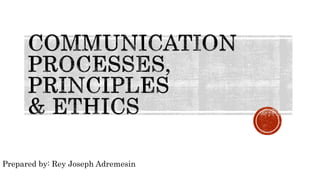
LESSON_1_COMMUNICATION_Processes_Princip [Autosaved].pptx
- 1. Prepared by: Rey Joseph Adremesin
- 2. At the end of the lesson you are expected to: Increase knowledge in communication, its processes and principles hence become more skillful communicators; Heighten awareness of communication ethics resulting in conscientious and respectful interactions; and Apply the gained knowledge through class exercises
- 3. Man can not communicate. Communication is very powerful. Everything created by the great Creator is incessantly engaged in various forms of communication. We are always engaged in almost all sorts of communication. Communication is something continuous and may not have a definite end.
- 4. Is a human act of sending (verbal or nonverbal; online of offline) and receiving of messages where interpretations are normally constructed in the process. Is a process whereby people create and transmit meaning through the exchange of verbal and nonverbal messages in a particular context (Oetzel, 2009:11). A natural activity of people
- 5. Purposive communication is an intentional communication that happens within the bounds of specific contexts. is a communication applied in a specific setting, environment, scene, social relations, and culture Contexts affect the process of sending and receiving of messages; semantics or meanings, choice of channels, words, and methods of delivery.
- 6. 1. Settings or environment – family, school, workplace, religious communities 2. Social relationships – friends, husband and wife, parent child, colleagues/boss-subordinate in the office 3. Scenes which include place, time and occasion – business meeting, job interview, social gathering – parties, weddings, etc.) 4. Culture – history, tradition, beliefs, norms, values
- 7. 1. Sender – source of idea (from WHOM) 2. Message - the idea being communicated (WHAT) 3. Channels – the medium of communication(HOW) 4. Receiver – where the message is going (to WHOM) 5. Feedback – response of the receiver to the message sent to him/her.
- 8. The source of idea Must be able to use the language that the receiver understands. Correct grammar Phonetics Choice of words or jargons for an appropriate audience Sentence construction Discourse competence
- 9. Delivery Good voice projection Use of appropriate eye contact Proper articulation of words and emphasis on important words “It’s not always what you say but how you say it.”
- 10. The FIVE C’s in communication: Courtesy Clarity Conciseness Concreteness Completeness
- 11. Courtesyis also known as politeness. Ways to demonstrate courtesy: Use polite words and tone to show respect to the receiver of the message. applying tact and diplomacy developing the “WE” attitude using positive words instead of negative being considerate of the feelings of the receiver selecting gender-free terms responding promptly to important messages
- 12. Clarity may involve correct word usage, grammar, pronunciation, sentence construction and delivery. Messages which are unclear oftentimes do not achieve their desired effect.
- 13. Conciseness is saying what needs to be said in as few words as possible. Avoid flowery words. Remember: “Our goal is to communicate and not to impress.”
- 14. Concreteness. This refers to being specific. - providing example when necessary makes a message more comprehensible.
- 15. Completeness. To avoid ambiguity, messages should not leave out important details that a receiver expects to know. Answer: What, Who, When, Where, Why and How
- 16. The choice of channel may depend on availability, practicality, and its impact on the receiver. Channels: Telephone Radio Television Printed texts (books, newspapers, magazines, journals, posters, etc.) Communication technologies (smartphones, tablets, computers)
- 17. Must have good listening and comprehension skills Eliminate all possible distractions or noises Types of noise (physical, environmental, psychological, emotional) Sharpness of cognition through continuous studies and acquisition of information and knowledge
- 18. The response of the receiver to the message sent to him/her. It enables you to evaluate the effectiveness of your message.